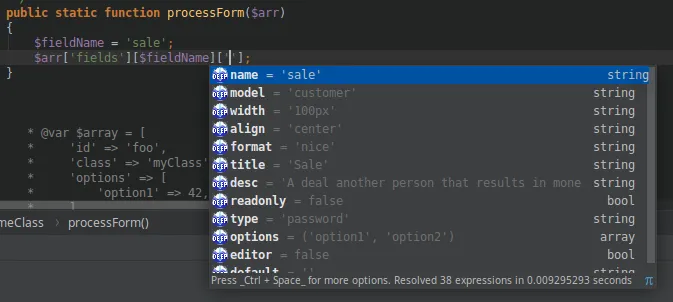我很难编写易读且易于理解的文档,以描述传递给函数的数组选项的多树结构。
以下是一个示例数组结构。
$arr = [
'fields' => [
'title' => [
'name' => 'Document.title',
'format' => 'string',
'readonly' => true
]
]
];
以上数组有许多可能的选项,但它作为参数传递给一个了解该结构的函数。
function doSomething(array $arr) { ... }
我希望记录下PHPDoc中数组应该如何结构化,但我不确定正确的方法是什么。
这是我现在拥有的。
/**
* Holds configuration settings for each field in a model.
* Defining the field options
*
* array['fields'] array Defines the feilds to be shown by scaffolding.
* array['fields'][fieldName] array Defines the options for a field, or just enables the field if array is not applied.
* array['fields'][fieldName]['name'] string Overrides the field name (default is the array key)
* array['fields'][fieldName]['model'] string (optional) Overrides the model if the field is a belongsTo assoicated value.
* array['fields'][fieldName]['width'] string Defines the width of the field for paginate views. Examples are "100px" or "auto"
* array['fields'][fieldName]['align'] string Alignment types for paginate views (left, right, center)
* array['fields'][fieldName]['format'] string Formatting options for paginate fields. Options include ('currency','nice','niceShort','timeAgoInWords' or a valid Date() format)
* array['fields'][fieldName]['title'] string Changes the field name shown in views.
* array['fields'][fieldName]['desc'] string The description shown in edit/create views.
* array['fields'][fieldName]['readonly'] boolean True prevents users from changing the value in edit/create forms.
* array['fields'][fieldName]['type'] string Defines the input type used by the Form helper (example 'password')
* array['fields'][fieldName]['options'] array Defines a list of string options for drop down lists.
* array['fields'][fieldName]['editor'] boolean If set to True will show a WYSIWYG editor for this field.
* array['fields'][fieldName]['default'] string The default value for create forms.
*
* @param array $arr (See above)
* @return Object A new editor object.
**/
我的问题是,在生成 HTML 文档时,它的格式不太好看。此外,我不确定上面的内容清楚地解释了数组结构。
是否有其他解决方案?

